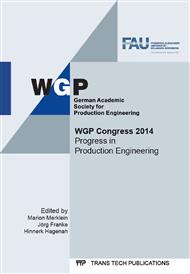[1]
G. W. Harvey, D. F. Brower: Metal Forming Device and Method. US-Patent 2976907, (1958).
Google Scholar
[2]
V. S. Balanethiram, G. S. Daehn: Hyperplasticity: Increased forming limits at high workpiece velocity. Scripta Metall. Mater. 30 (1994) 515-520.
DOI: 10.1016/0956-716x(94)90613-0
Google Scholar
[3]
T. Aizawa, M. Kashani, K. Okagawa: Application of magnetic pulse welding for aluminium alloys and SPCC steel sheet joints. Welding in the world 49 (2005) 212-222.
Google Scholar
[4]
V. Psyk, D. Risch, B. L. Kinsey, A. E. Tekkaya, M. Kleiner: Electromagnetic Forming – A Review. J. Mater. Process. Tech. 211 (2011) 787-829.
DOI: 10.1016/j.jmatprotec.2010.12.012
Google Scholar
[5]
S. Golovashchenko: Material Formability and Coil Design in Electromagnetic Forming. J. Mater. Eng. Perform. 16 (2007) 314-320.
DOI: 10.1007/s11665-007-9058-7
Google Scholar
[6]
S. Golovashchenko, N. Bessonov, R. Davies: Design and Testing of Coils for Pulsed Electromagnetic Forming. In: 2nd Int. Conf. on High Speed Forming, Dortmund, 2006, pp.141-151.
Google Scholar
[7]
C. Beerwald: Grundlagen der Prozessauslegung und -gestaltung bei der elektromagnetischen Umformung. Shaker, Aachen, (2005).
Google Scholar
[8]
M. Kleiner, A. Brosius: Determination of Flow Curves at High Strain Rates using the Electromagnetic Forming Process and an Iterative Finite Element Simulation Scheme, Annals of the CIRP Vol. 55/1/(2006).
DOI: 10.1016/s0007-8506(07)60413-2
Google Scholar
[9]
V. Psyk, C. Scheffler, W. -G. Drossel: Werkzeugauslegung für das elektromagnetische Fügen. Zeitschrift für wirtschaftlichen Fabrikbetrieb – ZWF 108 (2013) 831-836.
DOI: 10.3139/104.111037
Google Scholar
[10]
Information on http: /www. femm. info/wiki/HomePage.
Google Scholar
[11]
V. Psyk, T. Lieber, P. Kurka, W. -G. Drossel: Electromagnetic joining of hybrid tubes for hydroforming. In: 5th CIRP Conf. on Assembly Tech. and Systems, Dresden, 2014, Paper accepted.
DOI: 10.1016/j.procir.2014.10.063
Google Scholar


